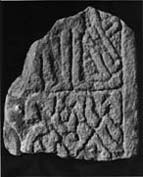Select a site alphabetically from the choices shown in the box below. Alternatively, browse sculptural examples using the Forward/Back buttons.
Chapters for this volume, along with copies of original in-text images, are available here.
Object type: Part of cross-shaft
Measurements: H. 39 cm (15.5 in); W. (max.) 29.2 cm (11.5 in); D. 12 cm (4.75 in)
Stone type: Medium-grained, bedded, micaceous sandstone
Plate numbers in printed volume: Pl. 159.821-823
Corpus volume reference: Vol 1 p. 165
(There may be more views or larger images available for this item. Click on the thumbnail image to view.)
Parts of only two carved faces survive. Both surviving faces are edged by a plain flat-band moulding.
A (broad): The remains of two panels in punched and grooved technique, divided by a single irregular line. (i) In the centre a frontal figure with grotesquely elongated legs, feet turned out, and traces of a short skirt. On the left a frontal or half-turned figure with feet turned out and a short skirt. On the right a figure leaning to the side and possibly holding a pole. (ii) A panel with attempted interlace.
B (narrow): A panel of punched and grooved interlace, so poorly executed as to be of no definable type.
C (broad) and D (narrow): Hacked away.
Face A is plausibly a Crucifixion scene with Longinus and Stephaton, but its poor technique, from what seems to be a local workshop, is almost impossible to date. It is interesting, however, that it seems to continue the formula of the Crucifixion scene with interlace panels, which is found on an earlier cross in the area at Alnmouth. Coatsworth (1973) considers that this Bothal Crucifixion iconography is ultimately dependent on a continental model (see also Discussion under 4). It is difficult to relate these crude carvings to other media stylistically. The grooved and punched technique of carving, found on all Bothal stones except 2, and to a certain extent the round-headed grave-marker, no. 6, is typical of late work in the north.



